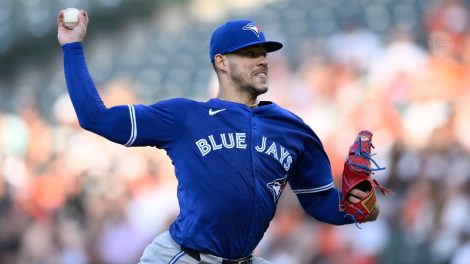TORONTO – The Toronto Blue Jays wanted Kyle Gibson, tabling the right-hander an offer of some sort well before he agreed to a $30-million, three-year deal with the Texas Rangers. It wasn’t enough, obviously, and after not buying Jake Odorizzi out of accepting a $17.8-million qualifying offer from the Minnesota Twins earlier this month, two of their preferred pitching options from the free-agent market are gone, their rotation still largely unbuilt.
So, as American Thanksgiving arrived Thursday, about a month into free agency, with back-end starter Chase Anderson the only addition to the major-league roster thus far, the Blue Jays must pivot.
To what plan, and to which targets? Good question.
In the short term, missing out on Gibson, a good arm with underlying peripherals that suggest upside, and Odorizzi, a solid starter who offers reliability, increases the chances the Blue Jays work something out with Matt Shoemaker ahead of Monday’s tender deadline.
The arbitration-eligible right-hander and the Blue Jays discussed an extension in September but those talks stalled. Given the right-hander’s recent injury history, a hearing is a somewhat unpredictable proposition for both sides, who seem to be waiting for the deadline to settle the matter.
Shoemaker offers the rotation upside – remember that he produced 1.2 WAR as calculated by Baseball Reference in only five starts before tearing the ACL in his left knee – at the expense of dependability, considering that he’s logged only 137.1 big-league innings the past three years.
[snippet id=4722869]
Still, he’s a worthwhile bet when you factor in his clubhouse presence and professionalism, and would leave the Blue Jays looking to fill two more rotation spots, where GM Ross Atkins and the front office are going to make or break their off-season.
To, at minimum, inject more innings to the rotation and protect the system’s young arms from overexposure, they’ll need to sign at least one innings-eater type of pitcher, someone in the Tanner Roark/Jordan Lyles/Wade Miley/Alex Wood vein.
Doing that would then allow them to hunt for some more impact, someone like Zack Wheeler or Hyun-Jin Ryu at the upper end of the spectrum, to the Dallas Keuchel/Michael Pineda types at the other end.
To get anything done, however, the Blue Jays are going to have to overpay and a question for them to wrestle with is whether it’s better to spend big on someone who could make a significant difference or to limit risk overpaying a smaller amount on someone with less upside.
Even in this era of stifled free agency, the words of Andrew Friedman, the Los Angeles Dodgers president of baseball operations, during the 2016 winter meetings ring true: “If you’re always rational about every free agent, you will finish third on every free agent.”
The reality for the Blue Jays is that as a rebuilding club in the American League East, there’s a premium to get an in-demand free agent to choose them. Toronto is a world-class city that deserves better, but some players still need to be enticed to move across the border. From a competitiveness standpoint, few are willing to slog it out with kids on the make when they can join a winner for similar money.
That means the Blue Jays will have to push out of their comfort zone, and accept the potential of bad money at the end of the deal as a cost of doing business.
Of course, if they’re unwilling to overpay in dollars, they can always use some of their prospect capital, a possibility that’s slightly increased now, too.
[snippet id=3305549]
The Blue Jays have already explored the markets for catchers Danny Jansen and Reese McGuire, as well as left-fielder Lourdes Gurriel Jr., and surely some of their other young big-leaguers, too, as a matter of due diligence.
But present-day big-league value is as expensive in trade as it is in free agency and will likely require an overpay of some sort. As former Boston Red Sox president of baseball operations David Dombrowski told me in July while referencing his costly acquisition of Chris Sale, “When you trade upside minor-league players, there’s no value that is going to give the weight needed to make that deal in a positive fashion.”
“Analytics is going to come back and say, ‘Well, this really isn’t a good trade,’” Dombrowski continued. “However, you also know that you’re picking up one of the best pitchers in the game of baseball, so you’re willing to sacrifice some of that future potential for now. And even the good analytical people will say, ‘Yeah, that’s understandable.’ But if you were just saying value for value, you would not be able to make a trade like that.”
One way or another, the Blue Jays are going to have pay more than they would like if they’re intent on adding impact to their rotation, rather than calculated/volatile dice-rolls. You can make a case for not spending on Odorizzi, or Gibson, or someone else what it would have taken to get them here, but there’s always a reason to not sign a player or not make a deal.
Thus far, the Blue Jays have stayed true to both their player valuations and walkaway points. With two of their targets now off the board and Plan B or C now in play, they’d do well stretching for the player they really want than overspending on one they’re settling for.
[relatedlinks]









